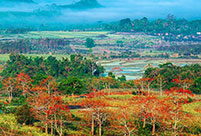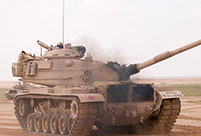

It is not thought the tomb (pictured) belonged to a member of the Han Dynasty royal family, however, because they were typically buried near the capital of Chang’an (modern Xi'an), which lay at the beginning of the important Silk Road trade route
However, excavations at the site are continuing.
A handful of Han burials, such as those of the Kings of Chu, yielded gold and jades, including an incredible jade suits and stone-inlaid coffins.
Jade was believed to protect the body from decay and demons.
Tombs were typically filled with provisions for the afterlife, such as jewellery, furniture, weapons and sometimes even cooks and servants who were sacrificed to serve their master for eternity.
Another two-storey tomb contained a small army of terracotta warriors and distinctive jades.
Most of the royal tombs containing a number of tombs were cut horizontally into the hillside - another suggestion this one did not hold a king.
Other types of Han tombs featured archways, vaulted cambers and domed roofs, with underground vaults held in place by earthen pits.
It is not clear from the photos released whether the newly discovered tomb is one of this type.
The 'new' tomb was found beneath the construction site of Beijing's second administrative centre in suburban Tongzhou.
Beijing is building a subsidiary centre in the suburb in a bid to cure ‘urban ills’ including overpopulation, traffic congestion and smog.
It is expected to relocate about 400,000 residents from the city centre to the suburban district.
 |  |
 Beautiful Kapok flowers bloom in Hainan
Beautiful Kapok flowers bloom in Hainan Eye-catching beauties in Chunxi Road of Chengdu
Eye-catching beauties in Chunxi Road of Chengdu Wedding pictures of Wu Qilong, Liu Shishi released
Wedding pictures of Wu Qilong, Liu Shishi released One of world's largest military drills in Saudi Arabia
One of world's largest military drills in Saudi Arabia Iron lady or goddess? Sportswomen's dress show
Iron lady or goddess? Sportswomen's dress show Versatile female soldiers in military camp
Versatile female soldiers in military camp Top beauties in Chinese provinces
Top beauties in Chinese provinces Follow me to my Weibo
Follow me to my Weibo Chinese ships keep close watch on U.S. Navy aircraft carrier strike group in S. China Sea
Chinese ships keep close watch on U.S. Navy aircraft carrier strike group in S. China Sea Top 20 hottest women in the world in 2014
Top 20 hottest women in the world in 2014 Top 10 hardest languages to learn
Top 10 hardest languages to learn 10 Chinese female stars with most beautiful faces
10 Chinese female stars with most beautiful faces China’s Top 10 Unique Bridges, Highways and Roads
China’s Top 10 Unique Bridges, Highways and Roads Cainiao completes first round of fundraising
Cainiao completes first round of fundraising Reviving NE China needs concrete support
Reviving NE China needs concrete support Elderly volunteers once seen as ‘tipsters’ now secure communities
Elderly volunteers once seen as ‘tipsters’ now secure communities Thanks to foreign translators, China’s thriving online lit scene is heading overseas
Thanks to foreign translators, China’s thriving online lit scene is heading overseasDay|Week